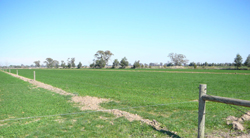4.1.2.2 - What slope, length and width should my bays have?
Return to Main Menu | Return to Step 4 | Return to Step 4.1 | Next Step
For more detailed information on designing irrigation bays, see Step 4.1.2.3 or the DPI Agnote “Border-check Irrigation Design” (external link) and the DPI publication “Irrigation system selection and design for northern Victoria: Volume 3: Design, implementation and operation considerations for border-check irrigation layouts”
For information on the design of farm channels, see “Farm Channels for Border Check Irrigation” (PDF 1.5MB), Rural Water Commission of Victoria (now Goulburn-Murray Water).
For information on the overall layout of bays channels and drains, laneways and grazing areas, see ”Designing Paddocks on an Irrigated Dairy Farm” (PDF 731KB), Rural Water Commission of Victoria (now Goulburn-Murray Water) (external link).
Computer models which simulate the border-check irrigation process can help in the design of optimum bay dimensions and slope. One such model is the Analytical Irrigation Model (AIM), developed at DPI Tatura particularly for the soils typical of the SIR. A description of the model and its use is given in “Irrigation system selection and design for northern Victoria: Volume 3: Design, implementation and operation considerations for border-check irrigation layouts”. For more information about the AIM model, contact DPI Tatura
To view the information PDF requires the use of a PDF reader. This can be installed for free from the Adobe website (external link).
Page top
Designing border-check irrigation bays for optimum efficiency and productivity is a complex process, involving a number of inter-related factors:
In addition, the bay designs have to be integrated into the Whole Farm Plan to achieve the optimum overall operation of bays, channels and drains, drainage reuse, laneways and grazing management. |
 The design of the bays is important for efficient irrigation |
For more detailed information on designing irrigation bays, see Step 4.1.2.3 or the DPI Agnote “Border-check Irrigation Design” (external link) and the DPI publication “Irrigation system selection and design for northern Victoria: Volume 3: Design, implementation and operation considerations for border-check irrigation layouts”
For information on the design of farm channels, see “Farm Channels for Border Check Irrigation” (PDF 1.5MB), Rural Water Commission of Victoria (now Goulburn-Murray Water).
For information on the overall layout of bays channels and drains, laneways and grazing areas, see ”Designing Paddocks on an Irrigated Dairy Farm” (PDF 731KB), Rural Water Commission of Victoria (now Goulburn-Murray Water) (external link).
Computer models which simulate the border-check irrigation process can help in the design of optimum bay dimensions and slope. One such model is the Analytical Irrigation Model (AIM), developed at DPI Tatura particularly for the soils typical of the SIR. A description of the model and its use is given in “Irrigation system selection and design for northern Victoria: Volume 3: Design, implementation and operation considerations for border-check irrigation layouts”. For more information about the AIM model, contact DPI Tatura
To view the information PDF requires the use of a PDF reader. This can be installed for free from the Adobe website (external link).


